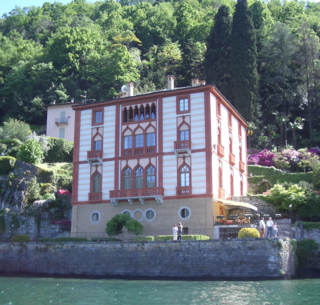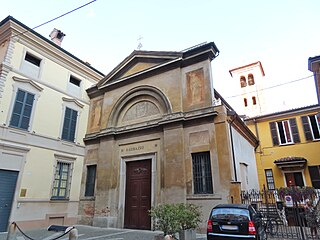
The Bank of Italy is the Italian member of the Eurosystem and has been the monetary authority for Italy from 1893 to 1998, issuing the Italian lira. Since 2014, it has also been Italy's national competent authority within European Banking Supervision. It is located in Palazzo Koch, via Nazionale, Rome.

Lodi is a city and comune (municipality) in Lombardy, northern Italy, primarily on the western bank of the River Adda. It is the capital of the province of Lodi.

The nobility of Italy comprised individuals and their families of the Italian Peninsula, and the islands linked with it, recognized by the sovereigns of the Italian city-states since the Middle Ages, and by the kings of Italy after the unification of the region into a single state, the Kingdom of Italy.

Villa Plinianina is a patrician rural palace on the shores of Lake Como, located in the comune of Torno, Province of Como, region of Lombardy, Italy.

Castell'Arquato is an Italian town located on the first hills of Val D’Arda in the province of Piacenza, in Emilia-Romagna, approximately 30 kilometres (19 mi) from Piacenza and 35 kilometres (22 mi) from Parma. Places nearby include Bacedasco, Vigolo Marchese, Fiorenzuola d'Arda, Lugagnano Val d'Arda, and Vernasca. It is one of I Borghi più belli d'Italia.

Duke or Duchess San Donato was a noble title, first created in 1602 by the Spanish King Philip III for the House of Sanseverino. The duchy was traditionally based on estates and territories held in San Donato di Ninea, Calabria. The first creation, however, lasted only 52 years. In 1668, the title was recreated for a wealthy merchant, Antonio Amitrano, who had some years earlier bought the feudal rights over the former dukes' territories. Descendants of the Ametrano family held the duchy, as one several titles, until it became extinct in the 1970s. There have been successive claims over the centuries by distant kinsmen of the first holders to claim the duchy; these remain unverified.

Villas and palaces in Milan are used to indicate public and private buildings in Milan of particular artistic and architectural value. Milan has always been an important centre with regard to the construction of historical villas and palaces, ranging from the Romanesque to the neo-Gothic, from Baroque to Rococo.

Palazzo Antonini also known as Palazzo Palladio and Palazzo Antonini-Maseri, is a palazzo in Udine, northern Italy. It was designed by Italian Renaissance architect Andrea Palladio in the middle of the 16th century for the Antonini family, owner of various other palaces in Udine.

Crédit Agricole Italia S.p.A., formerly Crédit Agricole Cariparma S.p.A., is an Italian banking group, a subsidiary of French banking group Crédit Agricole. Crédit Agricole Italia was ranked as the 11th largest bank in Italy by total assets at 31 December 2015. The group serving Emilia-Romagna, Liguria and Friuli-Venezia Giulia, where the predecessors originated, as well as Campania, Lazio, Lombardy, Piedmont, Tuscany, Umbria and Veneto, or half of Italian regions.

Piazza della Scala is a pedestrian central square of Milan, Italy, connected to the main square of Milan, Piazza del Duomo, by the Galleria Vittorio Emanuele II passage. It is named after the renowned Teatro alla Scala opera house, which occupies the north-western side of the square; the building actually includes both the opera house and the Museo Teatrale alla Scala, dedicated to the history of La Scala and opera in general. On the opposite side to "La Scala", to the south-east, is the facade of Palazzo Marino, Milan's city hall. Another relevant building on the square, on the north-eastern side, is the Palazzo della Banca Commerciale Italiana. The south-western side of the square has the entry to the Galleria Vittorio Emanuele as well as Palazzo Beltrami. Most of the architecture of the square is due to architect Luca Beltrami, who designed the eponymous palace, the facade of Palazzo Marino, and the Banca Commerciale Italiana building. The centre of the square is marked by the monument of Leonardo da Vinci by sculptor Pietro Magni (1872).

The Palazzo Corner Spinelli is a palace in Venice, northern Italy, located on the Grand Canal, in the sestiere of San Marco. It stands across the canal from the Palazzo Querini Dubois.

Palazzo Dolfin Manin is a palace in the sestiere of San Marco on the Canal Grande of Venice, northern Italy. It is located near the Palazzo Bembo and Palazzo Dandolo Paolucci, not far from the Rialto Bridge.

Piazza d'Aracoeli is a square of Rome (Italy), placed at the base of the Capitoline Hill, in the Rione X Campitelli.

Giovanni Bernardino Pollinari was an Italian painter, mainly of historic and sacred canvases, as well as portraits.

The Palazzo Zevallos Stigliano is a Baroque palace located on Via Toledo number 185 in the quartiere San Ferdinando of central Naples, Italy. It is also called the Palazzo Zevallos or Palazzo Colonna di Stigliano, and since 2014 serves as a museum of artworks, mainly spanning the 17th through the early 20th centuries, sponsored by the Cultural Project of the bank Intesa Sanpaolo. This museum is linked to the Museum or Gallerie di Piazza Scala in Milan and the Museum at Palazzo Leoni Montanari in Vicenza, also owned by the Bank.

The Palazzo Tolomei is an imposing, Gothic style urban palace, located on Via Banchi di Sopra in the present contrada of Civetta, Terzo di Camollia of the city of Siena, region of Tuscany, Italy.
Nuova Cassa di Risparmio di Ferrara S.p.A., known as Nuova Carife [New Carife] in short, was an Italian bank, based in Ferrara, Emilia-Romagna. Nuova Carife was founded on 22 November 2015 as a good bank that spin off from the original Cassa di Risparmio di Ferrara S.p.A. (Carife). The old Carife was under administration from 2013 and 2015, and now being liquidated as a bad bank. Nevertheless, Nuova Carife was a short-lived bank, which was acquired by BPER Banca in 2017 from Italian Resolution Fund, becoming branches of the banking group in the same year. The former majority shareholder and the old legal person of the bank, Fondazione Cassa di Risparmio di Ferrara, survived as a charity organization.

The Palazzo della Prefettura also called the Palazzo Scotti di Vigoleno is a Baroque architecture-style palace located on Via San Giovanni #17 in central Piacenza, region of Emilia-Romagna in Italy. The palace houses the offices of the provincial administration.

San Dalmazio is a Baroque style, Roman Catholic oratory or small chapel-church, located at via Mandelli #23, in front of the Palazzo Mandelli, in Piacenza, Region of Emilia Romagna, Italy.

The Teatro Municipale or Municipal Theater of Piacenza is the main Neoclassical-style opera house in the city, located on Via Verdi #41, facing Piazza Sant'Antonino and flanking the Palazzo Anguissola di Cimafava Rocca in Piacenza, Italy.



















